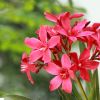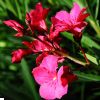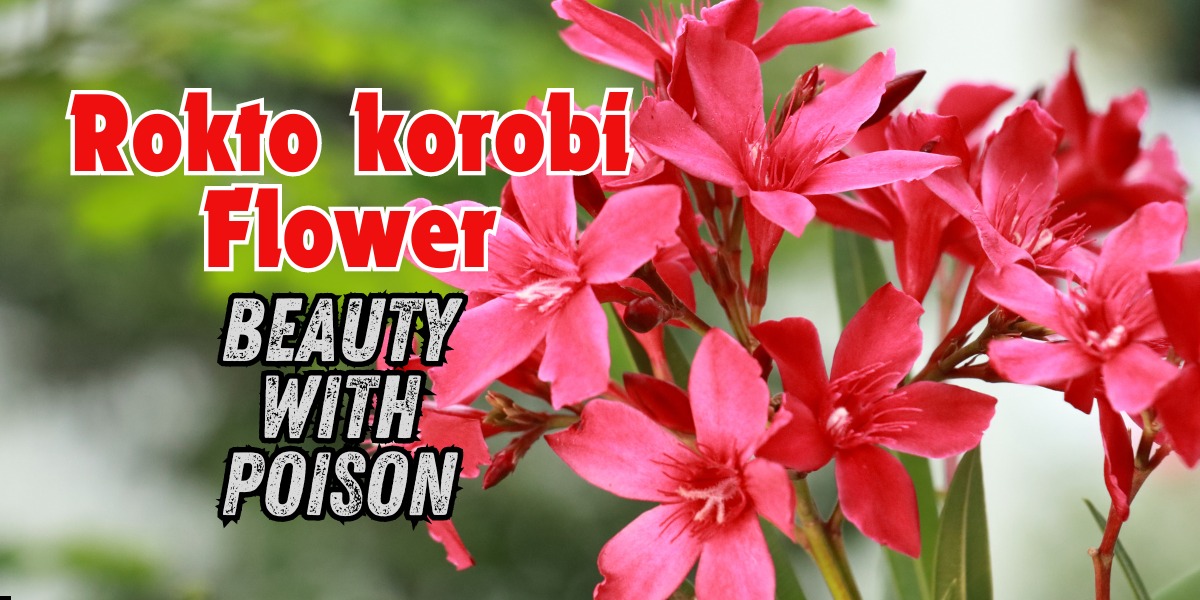The Rokto Korobi flower or Red Korobi Flower, a vibrant variety of Nerium oleander, is renowned for its fiery red blossoms. “Rokto” means “blood” in Bengali, aptly describing the deep, blood-red hue of this particular flower. Just like other oleanders, it is both admired for its beauty and approached with caution due to its toxic nature.
Appearance of Rokto Korobi Flower
Rokto Korobi Flower is distinguished by its stunning red flowers, which bloom in clusters, creating a bold and dramatic display. The flowers are trumpet-shaped with a sweet fragrance that can be quite alluring. The plant’s evergreen leaves are dark green, providing a striking contrast to the vivid red flowers.

Growing Conditions of Red or Rokto Korobi Flower
Rokto Korobi, like other Nerium oleander varieties, is a hardy and adaptable plant. Here are some tips for growing it successfully:
- Sunlight: Prefers full sunlight for optimal blooming.
- Soil: Thrives in well-drained soil, although it can tolerate poor soil conditions.
- Watering: While drought-tolerant, regular watering will encourage more prolific flowering.
- Pruning: Regular pruning helps maintain its shape and promotes new growth.
Advantages of Rokto Korobi Flower Plant:
- Ornamental Value: The deep red flowers of Rokto Korobi Flower are visually stunning, making it a popular choice for adding a splash of color to gardens and landscapes.
- Hardiness: It is a resilient plant that can withstand harsh conditions, including drought and poor soil.
- Versatility: Suitable for use as hedges, screens, or container plants, making it adaptable to various gardening needs.

Disadvantages of Rokto korobi Flower Plant:
- Toxicity: Like all oleanders, Rokto Korobi is highly toxic. All parts of the plant contain poisonous compounds, posing a risk to humans and animals if ingested.
- Invasive Potential: In some regions, it can become invasive, outcompeting native flora.
- Allergenic: The plant’s sap and pollen can cause skin irritation and allergic reactions in some people.

Comes with Different Type of Colour varieties
Toxicity Warning For Rokto Korobi Flower Plant:
The toxicity of Rokto Korobi cannot be overstated. Ingesting any part of the plant can lead to severe health issues, including nausea, vomiting, and potentially fatal heart problems. It is crucial to keep this plant out of reach of children and pets and to handle it with care, using gloves when pruning or touching the plant.
Conclusion
The Rokto Korobi flower, with its fiery red blooms, is a captivating addition to any garden. Its beauty and resilience make it a popular choice for ornamental use. However, its toxic nature requires careful handling and consideration. By understanding its advantages and disadvantages, gardeners can safely enjoy the striking beauty of Rokto Korobi in their landscapes.
What is the distinctive feature of the Rokto korobi flower?

The Rokto korobi flower is known for its striking deep red blooms, which stand out against its dark green foliage. The term “Rokto” means “blood” in Bengali, highlighting the vivid red color of the flowers.
Is the Rokto korobi flower toxic?

Yes, the Rokto korobi flower, like all varieties of Nerium oleander, is highly toxic. Ingesting any part of the plant can lead to severe health issues or even be fatal. Handle with care and keep away from children and pets.
Can Rokto korobi flowers be grown in containers?

Yes, Rokto korobi flowers can be successfully grown in containers, making them a versatile option for patios, balconies, and small gardens. Container plants can also be moved indoors during colder months in regions with harsh winters.
Are white korobi flowers suitable for floral arrangements?

While visually appealing, their toxicity makes them unsuitable for use in floral arrangements where accidental ingestion could occur.



3 thoughts on “Rokto Korobi Flower: Beauty With Poison”